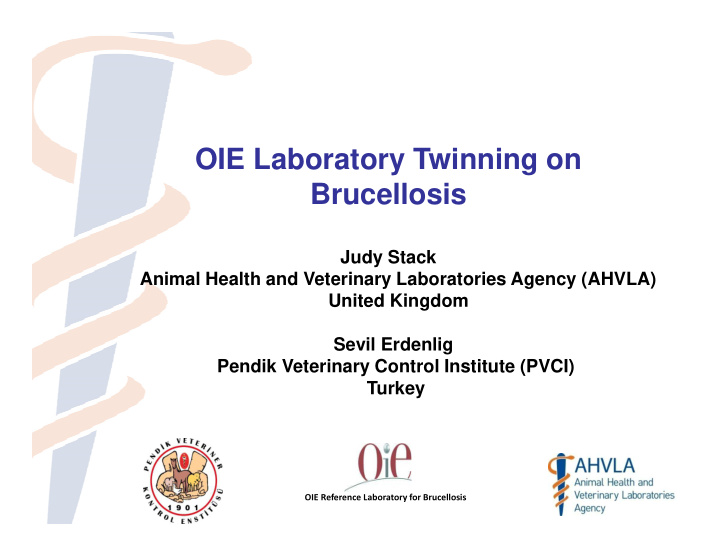



OIE Laboratory Twinning on Brucellosis Judy Stack Animal Health and Veterinary Laboratories Agency (AHVLA) United Kingdom Sevil Erdenlig Pendik Veterinary Control Institute (PVCI) Turkey OIE Reference Laboratory for Brucellosis
UK/Turkey Collaboration Laboratory Twinning pairs: Parent Laboratory: Animal Health & Veterinary Laboratories Agency (AHVLA) OIE Reference Laboratory and FAO/WHO Collaborating Centre for Reference & Research on Brucellosis Candidate Laboratory: Pendik Veterinary Control Institute (PVCI) Established National Reference Laboratory for Brucellosis Funded by World Organisation for Animal Health (OIE) for 3 years. Ensuring compliance with OIE guidelines for accurate diagnosis of disease.
OIE Laboratory Twinning: Aims • Develop or enhance sustainable relationships • Exchange knowledge/technical guidance • Improve compliance with OIE standards • Promote safe working procedures and facilities • Support to region & eventually for candidates to apply for ‘reference’ status • Extend the OIE network of expertise geographically
Why Brucellosis? • One of the worlds most significant zoonotic diseases in domestic livestock (and man) • Spreads easily, despite vaccination, control is difficult & expensive • Control programme essential – veterinary infrastructure - using validated laboratory tests • Causes abortion and reduced milk production: economic/human impact • Easily transmitted to humans causing potentially debilitating illness • Potential BW agent - reportedly weaponised historically by several states Hoover, D. L. & Friedlander, A. M. Brucellosis. In Textbook of Military Medicine: Medical Aspects of Chemical and Biological Warfare
Why PVCI? • Previous collaboration with UK group • Brucellosis endemic area • Experienced scientists - required specific training • Build on existing capacity to work towards OIE stipulations • Enhancing quality, biosafety & biosecurity • Benefits for both institutes and ultimately global disease awareness
Project Objectives Enhance the diagnostic capability of PVCI: • Training in new methods/oversight of existing methods • Prepare diagnostic standards according to OIE • To apply molecular techniques to obtain more details on epidemiological situation • Initiate a collection of material from infected animals for research and test validation • Ensure harmonisation of testing between PVCI & AHVLA and introduce proficiency testing
Summary of Outputs • Database of samples • Turkish National Standards and reagents complying to OIE Standards in large volumes • Harmonisation/ring trials/proficiency (for region and within Turkish diagnostic labs) • Raised international profiles – presentations/meeting attendance • Improved laboratory facility for safe and secure working at BSL3 • Molecular expertise and confidence • Application for Turkish Commercial funding • Future collaboration for both Institutes
Regional Workshop Post twinning workshop hosted by PVCI: • Representatives from 11 states across Middle East and Central Asia. • Delegates from OIE, WHO, FAO and GP. Aims: • To promote PVCI as a regional centre of expertise • To better understand regional brucellosis situation • To discuss regional approaches to surveillance and control Recommendations included: • PVCI and AHVLA working together to implement regional proficiency testing (going ahead) • Approaches to surveillance/control should be harmonised across region • Acknowledging success - countries to consider requesting OIE Twinning
Sustainable Project Benefits for both For Turkey: • Scientists competent in internationally approved methods • Accurate diagnosis of a disease of animal and public health concern • Ability to reach out to organise proficiency testing – audits – ring trials • Increased engagement with international scientific community • Joint research opportunities (both) • Working towards more regional engagement and OIE Reference Laboratory status For UK: • Increased awareness of international disease situation • Access to material for maintenance of competence, test validation and research • Career development opportunities for AHVLA scientists - communication, decision making, development of expertise etc.
Summary: Relevance to BTWC • Example of contribution to fulfilling Article X obligations. – Capacity building for detecting, reporting and responding to infectious disease outbreaks. – Twinning programmes to develop human resources. Laboratory Twinning is an excellent platform for strengthening cooperation and assistance between States Parties. • Such projects also reduce vulnerabilities and strengthen the Convention by: – Improving mechanisms for detecting, reporting and responding to outbreaks. – Enhancing biosafety and biosecurity. – Strengthening existing international organisations and networks working on infectious disease. – Promoting transparency and peaceful use of dual-use skills and knowledge.
Further information: Judy Stack, AHVLA judy.stack@ahvla.gsi.gov.uk Dr Sevil Erdenlig, PVCI sevilerdenlig@yahoo.com OIE Reference Laboratory for Brucellosis
Recommend
More recommend